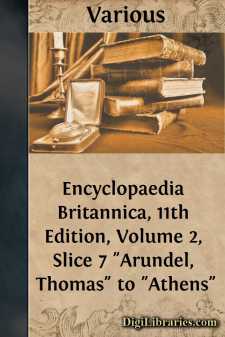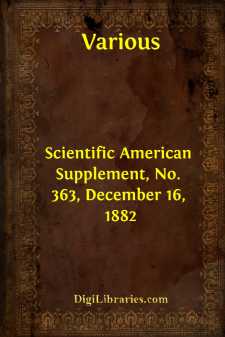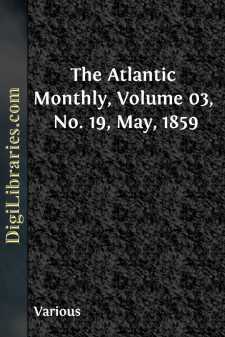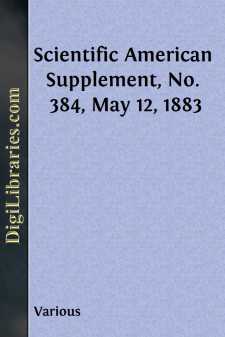Categories
- Antiques & Collectibles 13
- Architecture 36
- Art 48
- Bibles 22
- Biography & Autobiography 813
- Body, Mind & Spirit 141
- Business & Economics 28
- Children's Books 12
- Children's Fiction 9
- Computers 4
- Cooking 94
- Crafts & Hobbies 4
- Drama 346
- Education 46
- Family & Relationships 57
- Fiction 11826
- Games 19
- Gardening 17
- Health & Fitness 34
- History 1377
- House & Home 1
- Humor 147
- Juvenile Fiction 1873
- Juvenile Nonfiction 202
- Language Arts & Disciplines 88
- Law 16
- Literary Collections 686
- Literary Criticism 179
- Mathematics 13
- Medical 41
- Music 40
- Nature 179
- Non-Classifiable 1768
- Performing Arts 7
- Periodicals 1453
- Philosophy 64
- Photography 2
- Poetry 896
- Political Science 203
- Psychology 42
- Reference 154
- Religion 513
- Science 126
- Self-Help 83
- Social Science 81
- Sports & Recreation 34
- Study Aids 3
- Technology & Engineering 59
- Transportation 23
- Travel 463
- True Crime 29
Encyclopaedia Britannica, 11th Edition, Volume 2, Slice 7 "Arundel, Thomas" to "Athens"
by: Various
Categories:
Description:
Excerpt
ARUNDEL, THOMAS (1353-1414), archbishop of Canterbury, was the third son of Richard Fitzalan, earl of Arundel and Warenne, by his second wife, Eleanor, daughter of Henry Plantagenet, earl of Lancaster. His family was an old and influential one, and when Thomas entered the church his preferment was rapid. In 1373 he became archdeacon of Taunton, and in April 1374 was consecrated bishop of Ely. During the early years of the reign of King Richard II. he was associated with the party led by Thomas, duke of Gloucester, Henry, earl of Derby, afterwards King Henry IV., and his own brother Richard, earl of Arundel, and in 1386 he was sent with Gloucester to Eltham to persuade Richard to return to parliament. This mission was successful, and Arundel was made lord chancellor in place of Michael de la Pole, duke of Suffolk, and assisted to make peace between the king and the supporters of the commission of regency. In April 1388 he was made archbishop of York, and, when Richard declared himself of age in 1389, he gave up the office of chancellor, to which, however, he returned in 1391. During his second tenure of this office he removed the courts of justice from London to York, but they were soon brought back to the metropolis. In September 1396 he was translated from York to Canterbury, and again resigned the office of chancellor. He began his new rule by a vigorous attempt to assert his rights, warned the citizens of London not to withhold tithes, and decided appeals from the judgments of his suffragans during a thorough visitation of his province. In November 1396 he had officiated at the marriage of Richard and Isabella, daughter of Charles VI., king of France, and his fall was the sequel of the king’s sudden attack upon the lords appellant in 1397. After the arrest of Gloucester, Warwick and Arundel, the archbishop was impeached by the Commons with the king’s consent, although Richard, who had not yet revealed his hostility, held out hopes of safety to him. He was charged with assisting to procure the commission of regency in derogation of the royal authority, and sentence of banishment was passed, forty days being given him during which to leave the realm. Towards the end of 1397 he started for Rome, and Pope Boniface IX., at the urgent request of the king, translated him to the see of St Andrews, a step which the pope afterwards confessed he repented bitterly. This translation virtually deprived Arundel of all authority, as St Andrews did not acknowledge Boniface. He then became associated with Henry of Lancaster, but did not return to England before 1399, and the account which Froissart gives telling how he was sent by the Londoners to urge Henry to come and assume the crown is thought to refer to his nephew and namesake, Thomas, earl of Arundel. Landing with Henry at Ravenspur, he accompanied him to the west. He took his place at once as archbishop of Canterbury, witnessed the abdication of Richard in the Tower of London, led the new king, Henry IV., to his throne in presence of the peers, and crowned him on the 13th of October 1399....












